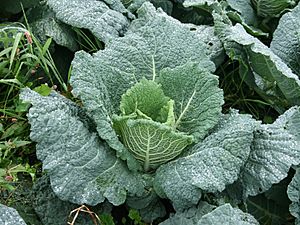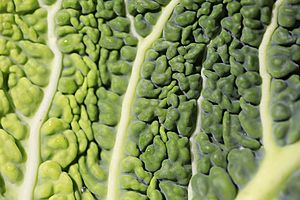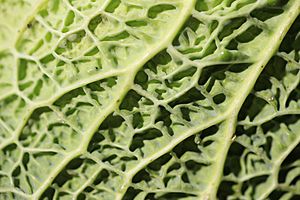Savoy cabbage facts for kids
Quick facts for kids 
Savoy cabbage
|
|
| Species | Brassica oleracea var. sabauda L. |
|---|---|
| Cultivar group | Brassica oleracea Savoy Cabbage Group |
| Cultivar group members |
|
 |
|
| Nutritional value per 100 g (3.5 oz) | |
|---|---|
| Energy | 113 kJ (27 kcal) |
|
6.1 g
|
|
| Sugars | 2.27 g |
| Dietary fiber | 3.1 g |
|
0.1 g
|
|
|
Protein
|
2 g
|
| Vitamins | Quantity
%DV†
|
| Vitamin A equiv.
beta-Carotene
lutein zeaxanthin
|
6%
50 μg
6%
600 μg77 μg
|
| Thiamine (B1) |
6%
0.07 mg |
| Riboflavin (B2) |
3%
0.03 mg |
| Niacin (B3) |
2%
0.3 mg |
| Pantothenic acid (B5) |
4%
0.187 mg |
| Vitamin B6 |
15%
0.19 mg |
| Folate (B9) |
20%
80 μg |
| Choline |
3%
12.3 mg |
| Vitamin C |
37%
31 mg |
| Vitamin E |
1%
0.17 mg |
| Vitamin K |
66%
68.8 μg |
| Minerals | Quantity
%DV†
|
| Calcium |
4%
35 mg |
| Iron |
3%
0.4 mg |
| Magnesium |
8%
28 mg |
| Manganese |
9%
0.18 mg |
| Phosphorus |
6%
42 mg |
| Potassium |
8%
230 mg |
| Zinc |
3%
0.27 mg |
| Other constituents | Quantity |
| Water | 91 g |
|
Link to USDA Database entry
|
|
| †Percentages estimated using US recommendations for adults. | |
Savoy cabbage is a special type of cabbage. It's a vegetable that grows well in winter. This cabbage gets its name from the Savoy region in France.
You can easily spot Savoy cabbage by its unique look. It has crinkled, deep green leaves. These leaves are crunchy and tender when you eat them. Some popular kinds of Savoy cabbage include 'Savoy King', 'Tundra', and 'Winter King'.
Contents
Cooking with Savoy Cabbage
Savoy cabbage is great for cooking because it stays firm. Even after it's cooked, it keeps its texture. This makes it perfect for many different recipes.
You can use Savoy cabbage in many ways:
- It tastes good with red wine, apples, and different spices.
- It's also tasty with horseradish and meat.
- You can use it to make roulades (rolled-up dishes).
- It's a good addition to stews and soups, like borscht.
- You can roast it with a little olive oil.
- It's even used in preserved foods like kimchi or sauerkraut.
- Some people use strong flavors like juniper with it.
Choosing and Storing Savoy Cabbage
When you pick Savoy cabbage, look for one that feels heavy. Its leaves should be bright and fresh, without any spots. The best time to buy most cabbages, including Savoy, is from November to April.
You can keep a whole, fresh Savoy cabbage in your refrigerator. It will stay good for about one to six weeks. Savoy cabbage is softer than other types, so it's best to eat it sooner. Don't wash the cabbage before storing it. Keeping the outer leaves on helps it last longer.
Health Benefits of Savoy Cabbage
Eating Savoy cabbage is good for you! It's full of important nutrients.
It provides:
- Fiber
- Vitamin A
- Vitamin C
- Vitamin K
- Vitamin B6
- folate
- potassium
- manganese
- Thiamin
- calcium
- iron
- magnesium
Growing Savoy Cabbage
Growing Savoy cabbage can be a bit tricky. It can be attacked by caterpillars and pigeons. It can also get a plant disease called club root.
Savoy cabbage grows best in sunny spots. It's a strong plant that can handle cold weather. It can even survive frost and snow!
See also
 In Spanish: Col de Saboya para niños
In Spanish: Col de Saboya para niños



